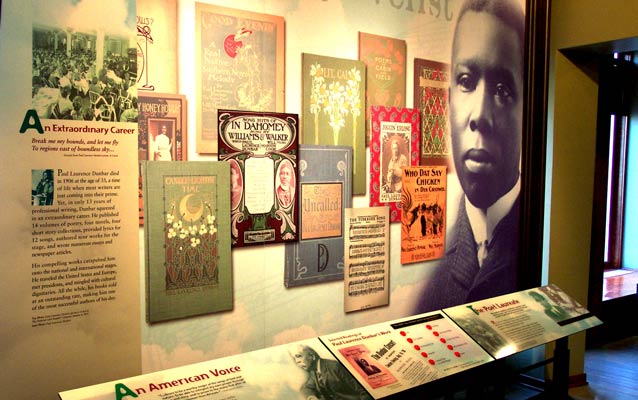Last updated: May 17, 2021
Place
Dayton Aviation Heritage National Historical Park

NPS Photo
Dayton Aviation Heritage National Historical Park comprises six sites in the greater Dayton, Ohio, area. The park boundary at these six sites encompasses 111 acres. Established in 1992, the partnership park preserves and interprets resources related to inventors Wilbur and Orville Wright, writer Paul Laurence Dunbar, and sites in Dayton associated with the early development of aviation.
There are five national historic landmarks and two national register historic districts within Dayton Aviation Heritage National Historical Park. These include the Wright Cycle Company building, Hoover Block, Huffman Prairie Flying Field, 1905 Wright Flyer III, Hawthorn Hill, and the Paul Laurence Dunbar State Memorial. Together, these sites tell the stories of the lives and legacies of Wilbur Wright, Orville Wright, and Paul Laurence Dunbar. The fourth Wright Cycle Company building and the Hoover Block are located at South Williams and West Third Streets. The fourth location of the bicycle shop operated by the Wrights is the only building remaining as testament to their bicycle business. The site was designated a national historic landmark in 1990. Wilbur and Orville Wright operated Wright & Wright, Job Printers, on the second floor of the Hoover Block from 1890 to 1895. The building houses the Wright-Dunbar Interpretive Center. The Hoover Block was added to the National Register of Historic Places as part of the West Third Street Historic District in 1988. The Wright-Dunbar Interpretive Center is co-located with the Aviation Trail Visitor Center and Museum. Aviation Trail, Inc., is one of the park’s partners.
Not far from the Wright Cycle Company and the WrightDunbar Interpretive Center is the Paul Laurence Dunbar State Memorial. Paul Laurence Dunbar, a transformational African-American poet, novelist, and playwright, lived in the house in west Dayton with his mother, Matilda Dunbar, from 1904 until his death in 1906. After Matilda Dunbar’s 1934 death, the State of Ohio acquired the property and opened it for public visitation as the first house museum commemorating an African American. It was designated a national historic landmark in 1962. The Paul Laurence Dunbar State Memorial is owned by the State of Ohio, managed by the Ohio History Connection, and operated jointly by NPS staff and Dayton History. The Ohio History Connection and Dayton History are two of the park’s partners. Occupying the grounds of Wright-Patterson Air Force Base, Huffman Prairie Flying Field is where the Wright brothers proved the aeroplane was a practical invention in 1904 and 1905. The 84-acre Huffman Prairie Flying Field was designated a national historic landmark in 1990. The Flying Field is on an active military installation, and as such, it is subject to unannounced closure
At Carillon Historical Park, the 1905 Wright Flyer III is the centerpiece of the Wright Brothers Aviation Center. The world’s first practical aeroplane, it was built by the Wright brothers in 1905 and flown at Huffman Prairie Flying Field. The Wright Flyer III was designated a national historic landmark in 1990 and a historic mechanical engineering landmark in 2003. Carillon Historical Park and the Wright Flyer III are owned and managed by Dayton History, one of the park’s partners.
Hawthorn Hill, south of central Dayton, is open for tours through Dayton History. In 1914, Orville Wright, Katharine Wright, and Milton Wright moved into this large Georgian revival style mansion in Oakwood. Orville, later joined by servants Charles and Carrie Kayler Grumbach, lived at Hawthorn Hill until his death in 1948. Hawthorn Hill was designated a national historic landmark in 1991.
The Wright Company factory in west Dayton opened in 1910 as the first factory in the United States designed especially for building aeroplanes, a testament to the brothers’ attempt to commercialize their invention. Students at the Wright School of Aviation also came here to learn plane controls on a simulator. The factory, currently in private ownership, is a new part of the park and is not yet open to the public.
Dayton Aviation Heritage National Historical Park is part of the National Aviation Heritage Area. Authorized by Congress in November 2004, the National Aviation Heritage Area honors the region’s leadership in the nation’s aviation history. The National Aviation Heritage Area provides visitors with an opportunity to experience several significant sites associated with aviation, including the sites of Dayton Aviation Heritage National Historical Park.
